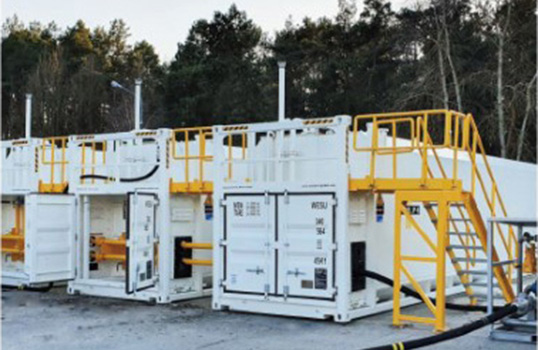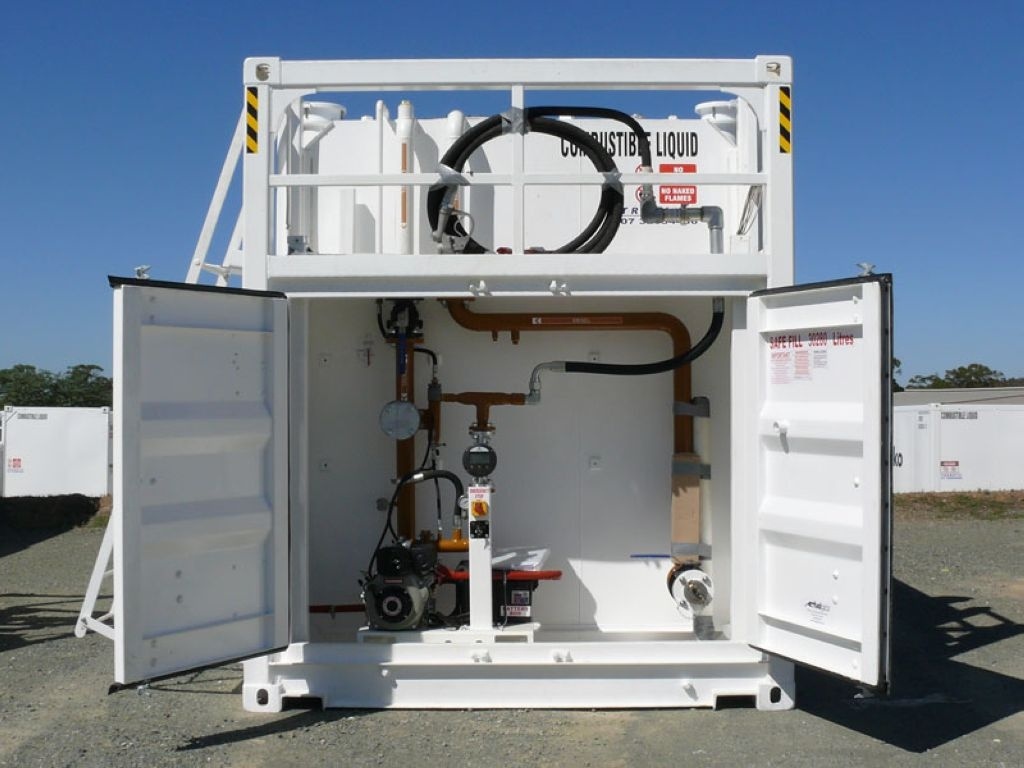I. Introduction
Containerized tanks and traditional storage tanks are essential components in various industries for the storage and transportation of liquids and gases. Containerized tanks are portable, standardized containers designed for easy transportation, while traditional storage tanks are typically fixed, larger structures built for long-term storage on-site.
Understanding the differences between these two types of tanks is crucial for businesses to make informed decisions regarding their storage needs. By examining their uses, benefits, and applications, industries can optimize their operations and ensure safe, efficient handling of materials.

II. Understanding Traditional Storage Tanks
Definition and General Description of Traditional Storage Tanks
Traditional storage tanks are large, stationary containers designed to hold various types of liquids or gases. These tanks are typically constructed from materials such as steel, concrete, or fiberglass and are built to remain in a fixed location. They are used extensively in industries that require the bulk storage of substances, providing a secure and stable environment for long-term storage.
Typical Uses and Applications in Different Sectors
Traditional storage tanks are utilized across a wide range of industries due to their ability to store large volumes of materials. Some of the most common applications include:
- Oil and Gas Industry: Used for storing crude oil, refined petroleum products, and natural gas.
- Chemical Industry: Stores various chemicals and hazardous substances that need secure containment.
- Water Treatment: Holds large quantities of water for municipal and industrial water treatment processes.
- Agriculture: Stores water for irrigation, as well as liquid fertilizers and pesticides.
- Food and Beverage Industry: Used to store ingredients, such as oils, syrups, and other bulk liquids.
Types of Traditional Storage Tanks
Traditional storage tanks come in several types, each designed to meet specific storage needs and environmental conditions. Some of the most common types include:
- Fixed-Roof Tanks: These tanks have a permanent roof attached to the tank shell. They are commonly used for storing liquids with low volatility, such as water and certain chemicals. The fixed roof provides protection against contamination and weather conditions.
- Floating-Roof Tanks: These tanks feature a floating roof that rises and falls with the liquid level inside the tank. This design minimizes the evaporation of volatile liquids, making floating-roof tanks ideal for storing petroleum products and other volatile substances. The floating roof reduces the build-up of vapor space, which helps in minimizing the risk of fire or explosion.
- Open-Top Tanks: These tanks do not have a roof and are typically used for temporary storage or for storing materials that do not require protection from environmental elements. Open-top tanks are often used in water treatment and certain agricultural applications.
- Pressure Tanks: Designed to hold gases or liquids under pressure, these tanks are built to withstand high internal pressures. They are commonly used in industries that require the storage of pressurized gases or high-pressure liquids, such as natural gas or certain chemicals.
- Underground Tanks: Installed below ground level, these tanks provide discrete storage solutions and are often used for storing hazardous substances that require extra protection from leaks and spills. They are commonly used for the storage of petroleum products and chemicals in urban areas where space is limited.
III. Key Differences Between Containerized Tanks and Traditional Storage Tanks
Mobility and Flexibility
- Containerized Tanks: These tanks are specifically designed for easy transport and relocation. Their standardized dimensions and durable construction make them ideal for shipping across various modes of transport, including road, rail, and sea. This mobility allows for flexible deployment in different locations as per operational needs.
- Traditional Tanks: Typically fixed in one location, traditional storage tanks are built for long-term storage needs. Once installed, they are not intended to be moved, making them less adaptable to changing logistical requirements.
Installation and Setup
- Containerized Tanks: Installation of it is quick and requires minimal infrastructure. They come pre-fabricated and can be set up with little preparation, making them suitable for temporary or rapid deployment scenarios. This ease of setup reduces downtime and allows for immediate use.
- Traditional Tanks: Traditional storage tanks require extensive foundation and infrastructure for installation. The process involves significant construction work, including site preparation, foundation laying, and often the construction of ancillary structures. This results in a longer setup time and higher initial investment.

Maintenance and Cleaning
- Containerized Tanks: These tanks offer easier access for cleaning and maintenance. Their design allows for quick disassembly and reassembly, enabling thorough cleaning and inspection. This accessibility ensures that maintenance routines can be conducted efficiently, minimizing operational interruptions.
- Traditional Tanks: Maintenance and cleaning of traditional storage tanks are more complex and time-consuming. Due to their large size and fixed installation, accessing all areas for cleaning or repairs can be challenging. Specialized equipment and procedures are often required, leading to longer downtimes and higher maintenance costs.
Cost Implications
- Containerized Tanks: Generally, containerized tanks involve lower initial setup costs. Their pre-fabricated nature and minimal infrastructure requirements contribute to reduced capital expenditure. Additionally, their flexibility can lead to cost savings in logistics and deployment.
- Traditional Tanks: The setup of traditional storage tanks incurs higher costs due to the extensive construction work required. These tanks often need significant site preparation and permanent infrastructure, leading to greater upfront investment. However, they may offer cost benefits in large-scale, long-term storage applications where mobility is not a priority.
IV. Advantages of Containerized Tanks
- Versatility in Use and Location
They offer exceptional versatility, making them suitable for a wide range of applications across various industries. Their design allows for easy relocation and adaptability to different storage needs. Whether you need temporary storage at a construction site, emergency water supply during a disaster, or mobile storage for hazardous materials, containerized tanks can be quickly deployed and repositioned as required.
- Cost-Effectiveness in Transportation and Storage
One of the major benefits of containerized tanks is their cost-effectiveness. These tanks are designed for intermodal transportation, meaning they can be easily transferred between trucks, trains, and ships without the need for unloading the contents. This seamless transfer reduces handling costs and minimizes the risk of spillage or contamination. Additionally, their standardized sizes fit perfectly on transport vehicles, optimizing space utilization and reducing transportation costs.
- Enhanced Safety and Containment Features
Containerized tanks are engineered with safety in mind. They often come with robust containment features, such as reinforced walls, secure locking mechanisms, and pressure relief systems. These features ensure that the contents are safely stored and transported, reducing the risk of leaks, spills, and accidents. This is particularly important for industries dealing with hazardous or volatile substances, where safety is a top priority.
- Ease of Compliance with International Shipping Standards
They are built to comply with international shipping standards, such as those set by the International Maritime Organization (IMO) and the International Organization for Standardization (ISO). This compliance ensures that the tanks can be used globally without facing regulatory hurdles. Their standardized design and certification make it easier for companies to navigate the complex logistics of international trade, ensuring that their goods are transported safely and legally across borders.
Containerized tanks offer unparalleled advantages in terms of versatility, cost-effectiveness, safety, and regulatory compliance, making them an ideal choice for a wide range of storage and transportation needs in various industries.
V. Advantages of Traditional Storage Tanks
- Large Capacity for Bulk Storage Traditional storage tanks are designed to hold large volumes of liquids, gases, or other substances, making them ideal for industries that require bulk storage solutions. Their substantial capacity allows for efficient management of resources, reducing the need for frequent refilling or transfers.
- Stability and Robustness for Long-Term Storage Traditional storage tanks are built with sturdy materials and reinforced structures, providing exceptional stability and durability. They are designed to withstand various environmental conditions, including extreme weather, making them suitable for long-term storage without compromising the integrity of the contents.
- Customization for Specific Industrial Needs One of the significant advantages of traditional storage tanks is their ability to be customized to meet specific industrial requirements. These tanks can be tailored in terms of size, shape, material, and additional features to suit the unique demands of different industries. Whether it’s for storing chemicals, petroleum products, water, or agricultural produce, traditional storage tanks can be adapted to ensure optimal performance and safety.
VI. Case Studies and Industry Examples
Containerized Tanks:
- Chemical Industry: Chemical manufacturers often use containerized tanks to store and transport hazardous chemicals safely. These tanks are designed to meet strict safety and regulatory standards, ensuring the integrity of the stored substances.
- Food and Beverage Industry: They are widely used in the food and beverage industry for storing liquids such as juices, wines, and edible oils. The hygienic design of these tanks helps maintain the quality and freshness of the products.
- Pharmaceutical Industry: Pharmaceutical companies use containerized tanks to store and transport pharmaceutical ingredients and products. These tanks are designed to meet the stringent requirements of the pharmaceutical industry, ensuring product safety and integrity.
Traditional Storage Tanks:
- Oil and Gas Industry: The oil and gas industry relies heavily on traditional storage tanks for storing crude oil, refined products, and chemicals used in the extraction and processing of oil and gas. These tanks are often large in size and are designed to withstand harsh environmental conditions.
- Water Treatment Industry: Water treatment plants use traditional storage tanks to store treated water before distribution to consumers. These tanks play a crucial role in ensuring a reliable supply of clean and safe drinking water to communities.
- Agricultural Industry: Farmers and agricultural businesses use traditional storage tanks for storing water, fertilizers, and pesticides. These tanks help ensure a steady supply of agricultural inputs, contributing to efficient farm operations and higher yields.
VII.Conclusion
In conclusion, containerized tanks and traditional storage tanks play vital roles in various industries, offering distinct advantages and applications. Containerized tanks excel in mobility, versatility, and cost-effectiveness, making them ideal for temporary or portable storage needs. On the other hand, traditional storage tanks are renowned for their large capacity, stability, and customization options, making them suitable for long-term and specific industrial applications.
It is crucial for businesses to carefully assess their storage requirements and select the appropriate tank type based on their operational needs and logistical constraints. By understanding the differences and benefits of each tank type, industries can optimize their storage solutions, ensuring safe and efficient handling of liquids and gases.
Looking ahead, future trends in storage tank technology may include advancements in material science, enhanced safety features, and increased automation and monitoring capabilities. These developments aim to further improve the efficiency, safety, and sustainability of storage tank systems, meeting the evolving needs of modern industries.
CIMC Yang Zhou Base is a leading manufacturer of containerized tanks and various other standard and special logistics equipment. With years of experience in the industry, it focuses on the design, production and distribution of high-quality innovative products that meet the specific needs of customers. |


